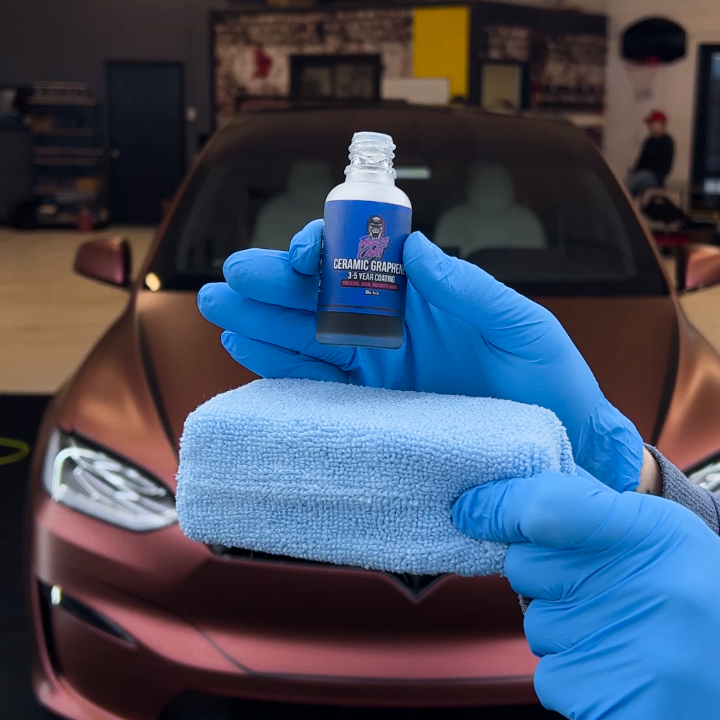Ceramic Pro: Protect and Improve Your Auto with Advanced Innovation
Ceramic Pro: Protect and Improve Your Auto with Advanced Innovation
Blog Article
The Scientific Research Behind Ceramic Finish: How It Improves Your Vehicle's Aesthetic and Sturdiness

Comprehending Ceramic Coating Chemistry
The chemical structure of ceramic coatings plays a vital duty in establishing their toughness and protective properties on vehicle surface areas. Ceramic finishes are generally composed of silicon dioxide (SiO2), which is a key component offering solidity and warm resistance. Various other components such as titanium dioxide, silicon carbide, and polysilazanes are commonly included in boost details buildings like UV resistance, adhesion, and hydrophobicity.
Silicon dioxide, additionally called silica, creates a clear and strong layer on the lorry surface area when applied appropriately. This layer works as a shield, safeguarding the paint from ecological contaminants, UV rays, oxidation, and chemical stains. Titanium dioxide assists in blocking dangerous UV rays that can create paint fading and damage. Silicon carbide is recognized for its abrasion resistance, making the ceramic covering durable and challenging versus physical damage. Polysilazanes are used to improve the layer's flexibility and attachment to the automobile's surface, guaranteeing resilient defense. Understanding the chemistry behind ceramic coatings is essential for both applicators and lorry owners to value the value and benefits these finishes offer in keeping the aesthetic allure and longevity of lorries.
Improved Gloss and Mirror-like Complete
Recognizing the chemical structure of ceramic coatings not only reveals their protective properties yet also clarifies exactly how they add to accomplishing an enhanced gloss and mirror-like finish on automobile surface areas. The secret to the shiny effect hinges on the nano-ceramic fragments existing in the coating. These bits load in tiny pores and flaws externally, producing a smooth and degree finish. As light hits the layered surface, it shows evenly, giving the look of a deep, shiny sparkle. Additionally, the chemical structure of ceramic coatings permits them to create a strong bond with the automobile's paintwork, stopping oxidation and keeping the clearness of the coating over time. This bond also withstands environmental pollutants, such as dirt and grime, that can plain the shine of the vehicle. The mix of filling up properties, light reflection, and resilient security makes ceramic finishes a preferred choice for those looking for a dynamic and mirror-like surface for their cars.

Impact on Paint Protection and Durability
Ceramic coverings for automobiles considerably boost the longevity and protection of the paintwork. By creating a chemically immune layer in addition to the vehicle's clear coat, ceramic layers serve as an obstacle against various ecological impurities that can harm the paint over time. These finishes are created to fend off dust, water, road salt, bird droppings, and other hazardous substances, reducing the threat of paint oxidation and deterioration. Additionally, the hardness of ceramic coverings supplies a degree of scratch resistance, aiding to preserve the vehicle's appearance for an extended duration.
In terms of longevity, ceramic coatings offer a long lasting service compared to standard waxes or sealants. While waxes may last a few weeks to a few months, ceramic layers can last years with appropriate upkeep. This extended life expectancy not just reduces the frequency of reapplications yet also saves effort and time over time. On the whole, the safety residential properties of ceramic layers contribute considerably to maintaining the automobile's paintwork and enhancing its aesthetic allure over an extended duration.
Resistance to Pollutants and Harsh Components
With the safety shield given by ceramic finishes against various environmental pollutants and components, vehicles are able to keep their immaculate look in spite of direct exposure to extreme problems. Ceramic finishes develop a strong obstacle that pushes back water, dirt, dirt, and other typical toxins, preventing them from bonding to the lorry's surface area.
Furthermore, ceramic layers use UV protection, securing the automobile's paint from the check these guys out sunlight's harmful rays that can trigger fading and oxidation. This resistance to UV damages aids keep the color strength and luster of the paint for longer durations. By forming a resilient and lasting obstacle, ceramic finishes make sure that the car's outside stays shielded versus a vast array of impurities and severe aspects, preserving its aesthetic allure and sturdiness.
Application Methods and Upkeep Tips
For optimal outcomes when applying ceramic layers to vehicles, using appropriate techniques and adhering to advised maintenance practices are important. Prior to using the ceramic coating, it is important to extensively clean and sanitize the car's surface area to guarantee correct bond.
When applying the ceramic finishing, it is suggested to operate in little areas to make sure even protection and to avoid the item from drying out too rapidly. Using applicator pads or microfiber cloths, use the coating in a crisscross or up-and-down movement, relying on the item's instructions. After the finishing is applied, permit it to treat for the defined time prior to buffing off any kind of deposit.
In terms of maintenance, routine washing with pH-neutral soaps and preventing abrasive tools or extreme chemicals will certainly assist maintain the ceramic coating's integrity. Periodic examinations for any kind of damages or use on the finishing can likewise aid keep its safety properties gradually.

Verdict
In conclusion, ceramic layer enhances a car's aesthetic allure and resilience with its chemical structure, providing a shiny surface and securing the paint from ecological contaminants. Its resistance to harsh elements and ease of upkeep make it a popular choice for cars and truck proprietors looking to maintain the appearance of their lorries. On the whole, check out this site ceramic finishing is a scientifically backed solution for keeping the appearance and longevity of your lorry.
Comprehending the chemistry behind ceramic coatings is crucial for both applicators and lorry proprietors to value the value and advantages these coatings offer in maintaining the visual appeal and long life of cars. (ceramic pro)
Understanding the chemical composition of ceramic finishings not only reveals their safety residential or commercial properties yet also loses light This Site on how they contribute to accomplishing an enhanced gloss and mirror-like finish on automobile surfaces. By creating a chemically resistant layer on top of the lorry's clear layer, ceramic coverings act as a barrier versus different environmental contaminants that can harm the paint over time. On the whole, the protective homes of ceramic finishings add significantly to maintaining the car's paintwork and boosting its aesthetic allure over an extensive duration.
In final thought, ceramic finish improves a lorry's aesthetic charm and resilience via its chemical composition, providing a shiny finish and protecting the paint from environmental impurities.
Report this page